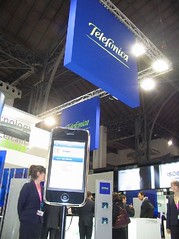 Image by blogpocket via Flickr
Image by blogpocket via FlickrGoogle is building the second momentum after the Android push with plans for a super-fast fiber network to half a million homes across America. This should send alarm bells ringing for the traditional telcos. Google has also slowly but inevitably started to focus on hardware with its Nexus One phone. There is a lot of talk as to which entity would be able to pose a counter to Google's hurtling advances. Its not difficult to imagine Google taking a big chunk of the market by showing a will to controlling customers data. Now's the time for a player to like Nokia to consolidate non-American market by making (pretty) big investments on OS, platform and an ecosystem to take advantage of the latent period when the strong American players ( Google, Apple) fight it out among themselves.
What about RIM, the makers of the well accepted Blackberry smartphones? RIM had wriggled out of very tricky situations in the past and has gained strength in the enterprise segment significantly and is still the leader in the smartphone segment in the US market, which is a big thing seen along with the growth of iphone. During the course of last year some businesses had indeed switched over to iphones for their workforce. However this trend has not appreciably picked up and I think the Android moment had a side effect of delaying large scale enterprise shift from Blackberry centric policies. RIM is certainly a strong player with notable innovation strengths and is bound to play a dominant role in the near future.
The other news that has made a splash is that of Motorola splitting itself into two companies. Now the mobile phone business would be an attractive proposition for potential suitors. It has been a theme with Motorola to spin off the mobile phone business at an appropriate time and Motorola had driven cost measures aggressively and has got a measure of success. My hunch is that the mobile phone business would be lapped up by some PE group or the other option - being taken over by a big player - Google comes to mind... let us wait and see.
![Reblog this post [with Zemanta]](http://img.zemanta.com/reblog_e.png?x-id=2e259dfb-5e69-43a6-b7c1-4ff2f69d08bd)



![Reblog this post [with Zemanta]](http://img.zemanta.com/reblog_e.png?x-id=6e2cb2ee-1b43-474b-a4a9-8ccc4acc27c5)



























